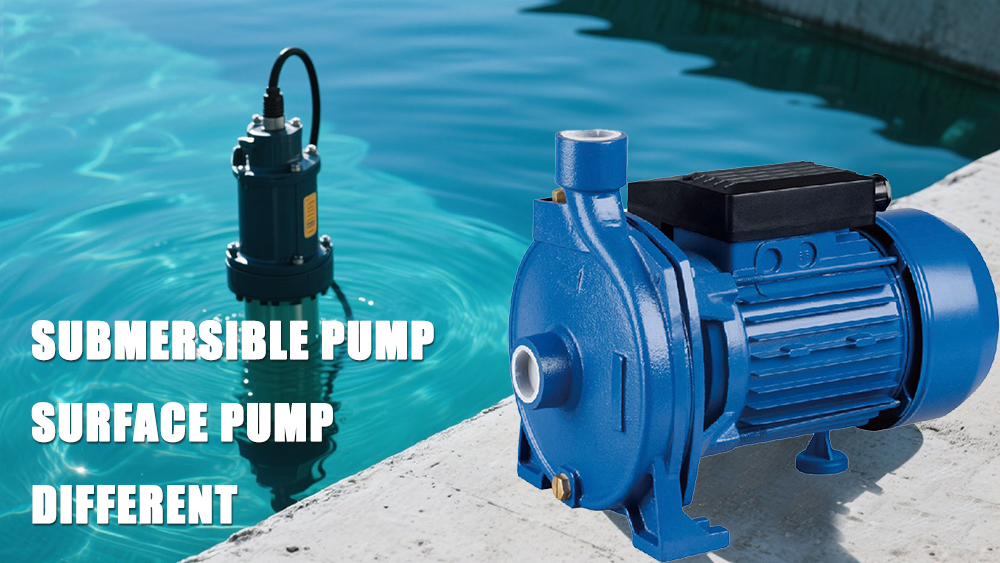+86 13816508465
Pump Knowledge
May. 26, 2025

Choosing the right pump for your water needs can feel overwhelming, especially when faced with technical terms like 【submersible】and 【surface】 pumps. Both types offer unique benefits and are suited for different applications, but understanding their key differences is essential for making the right choice.
This guide will explore what submersible and surface pumps are, their features, common uses, and how to determine the best option for your specific requirements. By the end of this post, you'll have the knowledge you need to take the guesswork out of your decision-making.
What is a Submersible Pump?
A submersible pump is designed to operate while completely submerged in a liquid, such as water or sewage. Its motor is sealed and waterproof to prevent damage and ensure functionality even under water.
Key Design Features
· Waterproof Motor: Encased in a sealed housing to protect internal components.
· Push Mechanism: Unlike surface pumps that rely on suction, submersible pumps work by [pushing] liquid to the surface.
Common Applications
· Deep Wells: Ideal for extracting water from deep underground sources.
· Flood Control: Frequently used to drain floodwaters during emergencies.
· Sewage Management: Efficiently handles wastewater in residential and industrial settings.
With their ability to work quietly and withstand harsh conditions, submersible pumps are a popular choice for demanding, deep-water applications.
What is a Surface Pump?
Surface pumps, as their name suggests, are installed above ground and typically placed beside a water source. They operate by drawing water using suction or centrifugal force.
Key Design Features
· Non-Submersible Design: Placed outside the water source, making them easier to inspect and maintain.
· Suction Mechanism: Relies on atmospheric pressure to draw water to the pump, making it suitable for shallow sources.
Common Applications
· Irrigation: Perfect for watering fields, gardens, and landscaping.
· Water Transfers: Efficiently transfers water between tanks or ponds.
· Shallow Wells: Works well for sources where the water level is close to the surface.
Surface pumps are straightforward and cost-effective, making them a preferred option for small-scale projects and shallow water sources.
Key Differences Between Submersible and Surface Pumps
Understanding the technical differences between these pumps will help clarify which is better suited to your needs. Below is a side-by-side comparison of key features:
Feature | Submersible Pump | Surface Pump |
Installation | Operates while fully submerged in water. | Installed above ground, near the water source. |
Efficiency | Highly efficient; no energy loss to suction | Lower efficiency, limited by suction force. |
Maintenance | Harder to access for repairs. | Easy to inspect and maintain. |
Noise Level | Quiet; sound is absorbed by water. | Louder operation. |
Depth Handling | Ideal for deep wells (100+ feet). | Best for shallow sources (<25 feet). |
Cost | Higher initial cost. | More budget-friendly upfront. |
Pros and Cons of Submersible and Surface Pumps
To further simplify your decision, let's break down the pros and cons of each type:
Submersible Pump
Pros
· Extremely efficient with little to no energy loss.
· Operates quietly due to water muffling the sound.
· Can handle deep-water applications with ease.
Cons
· Higher initial investment is required.
· Difficult to access for maintenance or repairs.
Surface Pump
Pros
· Easy to install and maintain, with components readily accessible.
· Affordable upfront cost.
· A good choice for small-scale tasks like garden irrigation.
Cons
· Limited to shallow water sources, typically less than 25 feet deep.
· Louder during operation.
· Prone to cavitation (formation of air bubbles) if not properly maintained.
How to Choose the Right Pump for Your Needs
When deciding between a submersible and a surface pump, it's important to consider these factors:
1. Water Source Depth
· If the water source is deeper than 25 feet, a submersible pump is your only viable option.
· For shallow sources closer to the ground, a surface pump will suffice.
2. Budget
· Submersible pumps have a higher upfront cost but provide long-term durability.
· Surface pumps offer an affordable entry point for less demanding tasks.
3. Noise Tolerance
· Choose a submersible pump for quieter operations, especially in residential settings.
· Surface pumps may not be ideal in noise-sensitive environments.
4. Ease of Maintenance
· If you need a pump that’s easy to repair or inspect, a surface pump is your best bet.
Example Scenarios
· Submersible Pump: Ideal for deep wells, farms, or flood-prone areas requiring high-performance pumping.
· Surface Pump: Great for garden irrigation, transporting water between tanks, or small water supply tasks.
Matching the Pump to Your Needs
The key to selecting the right water pump lies in understanding the specifics of your project. Submersible pumps shine in demanding, deep-water applications, providing unparalleled efficiency and performance. Meanwhile, surface pumps offer simplicity and cost savings for shallow-water tasks.
Whichever type you choose, ensure it aligns not just with the technical requirements of your job but also with your budget and maintenance preferences. If you're still unsure, consulting an expert or exploring various models is the best next step.
Address
No.17 XeDa Jimei Ind. Park, Xiqing Economic Development Area, Tianjin, China
Telephone
+86 13816508465
QUICK LINKS